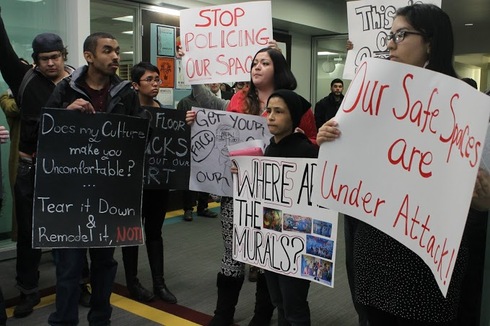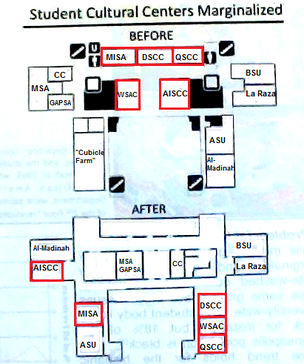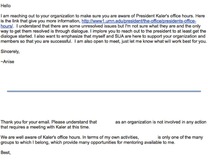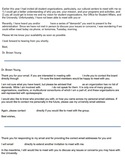Whether we agree or disagree does not concern me as much as the dialogue and its potential to stimulate critique. I also want to warn that if you seek categorical, definitive answers, you will not find them. I will submit more questions, more interventions, as I continue to speak from the margins, as I continue to experiment with my own “sitio y lengua,” never forgetting that I am simulating voices that lived and thrived long before me, before you, before any of us.
Emma Pérez
Whose Diversity? is committed to uncovering these complexities, in part because these sites are rarely created, but mostly because we seek to enact change. We feel that in pushing for nuanced dialogues we will collectively highlight the voices of people who are relegated to the margins by our administration. Our conversation is centered around the need to make visible the history of struggle and resistance on our campus, a conversation that must take place from the ground up, rather than in the opposite direction. With this in mind, we decided to attend the unveiling ceremony of the second floor in Coffman Memorial Union. We recognized the urgency to introduce a counter-narrative that nuanced the narrative presented by the University’s administration with respect to the redesign of the second floor.
The second floor of Coffman Memorial Union houses the student cultural centers, including the Black Student Union, La Raza Student Cultural Center, the Women’s Student Activist Collective, the Disabled Student Cultural Center, the Queer Student Cultural Center, the American Indian Student Cultural Center, and more. These organizations are crucial to the survival of students from these historically marginalized communities, particularly considering that the University fails to provide safe spaces for them/us elsewhere. While the University offers sites that (at least on paper) are intended to provide services and support for these students, the student cultural centers provide physical locations on campus where students from underrepresented communities can socialize with people of similar backgrounds and experiences. For most students, these are the only safe spaces available to them on campus.
In 2010-11, these spaces came under threat, and so did the University. On November 17, 2010, the MN Daily reported about this, noting that, “Paul Freeman, former chairman of the Student Services Fees Committee, sent letters to Vice Provost Jerry Rinehart to address the space allocation issues.” This complaint that superficially addressed the process for space allocation for student groups escalated into a lawsuit threat. Crucial to this conversation is to note that this complaint/lawsuit masked an agenda rooted in a history of white supremacy and colonial violence in the United States. Historically marginalized people are constantly forced to fight for safe spaces and representation, and this was just another example of that.The University created public forums where students were invited to present testimony and to advocate on behalf of the student cultural centers. These forums became sites of violence, where students from historically marginalized communities felt forced to testify, presenting heartfelt testimonies to defend the need to have the student cultural centers. Students talked about these spaces being the only spaces where they felt safe, a safety that students of privileged backgrounds are granted elsewhere on campus.
Despite students’ pleads, the administration moved forward with its plans. They imposed lease agreements on the student cultural centers, which the administration claimed would have to be signed every two years, but mysteriously became annual requirements during the summer transitional period. These contracts also stated that student cultural centers would be assigned a grade (green, yellow, or red) based on their performance. They were told that if the University decided to terminate their lease, they would have to “quietly yield and surrender the Assigned Space” (Student Organization Space Use Agreement).
Murals that contained a powerful history of struggle and resistance on campus, the very struggle that led to the institution of the African American and African Studies Department, as well as the Chicano Studies Department, were demolished. Even though students stood up and fought back to try and defend these historical murals, the administration claimed that it would be too costly to preserve them. They instead spent approximately $2.5 million to replace the mural with digital images (which can be accessed in a touchscreen on the second floor) and to reconstruct the second floor; it was painfully embarrassing to see the artist who created one of the murals come in to pick up pieces of his demolished work.
Several students continued working with the administration to advocate for a space that would acknowledge and respect the voices of the students from the student cultural centers. This led to the creation of SFAC, the Second Floor Advisory Committee. While the space was originally created to provide a safe space where student voices would be centered, power differentials between the students and the administration (as well as between representatives of the student cultural centers) now permeate the space, making SFAC meetings the site where students are told what the administration wants from them.
After the redesign took place, students voiced their concerns about the “feel” of the newly redesigned second floor, stating that the space felt sterile, that it no longer felt like home. As it stands, the second floor features white walls (for more info on colonialism and chromophobia, click here); the walls are movable, which makes students suspect that they were installed this way to facilitate the removal and the potential sectioning of assigned spaces. In addition, the new layout features the student groups that represent marginalized communities literally on the margins (see map).
The Second Floor Corridor Gallery showcases diverse original art created by students, members of the university, and the greater Twin Cities community. We hope the exhibits will create dialogue and foster greater cultural awareness.
- Hey, where are the murals?
- No, really, where are they?
- Are you re-creating them?
- Are the spaces properly labeled according to the American with Disabilities Act?
- How much did the renovation cost?
- How much of that money are you spending on the student cultural centers?
- How does the renovation promote and foster diversity of ideas, cultures and experiences?
- Where are the students of color?
- Where are the faculty of color?
- This space feels sterile.
- This space has no color.
- This space feels segmented.
- This space feels whitewashed.
- This space is no longer what it was.
- This space is unwelcoming.
- This space has no soul.
- Whose diversity are we celebrating?
- Whose diversity strives in this university?
- Where is the diversity? Not in this university!
The administration also invited a former student organizer to speak on their behalf. One student from the crowd told the former organizer that she could “speak some truths, we’ll have your back,” but instead the speaker proceeded to state that the protesters did not know the history of the renovation, which was a misleading statement. At the end of the speaker’s speech, the student in the crowd stated, “This is what divide and conquer looks like!” and stated, “I also have a lot of love and respect for you [...] but it sounds like you are not being told the whole truth. I’d be happy to have a conversation with you to fill you in on the details of what’s been going on lately,” an invitation that has yet to be accepted.
Days later, another student overheard three men in suits discussing the event as they rode the university’s free shuttle. One of the men made a comment about an organizer of the protest being a university employee, to which another replied “I think I heard that! Can you believe that?!” According to the witness, there was some laughing and then one of them said, “Let’s see how long that lasts.”
It is our responsibility to take every opportunity available to ensure that our stories, particularly those of struggle and resistance, continue to be told. It is our duty to ensure the continued acknowledgment and inclusion of historically marginalized communities in the dominant imagery. As the future professors, economists, administrators, and leaders of our communities, we have a responsibility to include the voices that continue to be rendered unimportant, and to publicly demonstrate the consequences of being perceived as a threat to the status quo. We can no longer afford to remain silent, passive, or “neutral,” as this neutrality and passivity allow the continuation of culturecide that is so deeply embedded in the mainstream narratives of our country and our university.
It becomes crucial to remember that many acts of genocide and culturecide are committed in the name of progress. We are often told to “get over it” – “You’re still complaining about slavery? Get over it!” “The Indians lost the war, get over it!” “Mexico lost, the U.S. won, get over it!” “Your department will no longer exist, get over it!” “So what if you lost some murals? Get over it!” Often times, acts of violence and oppression are dismissed by those in power, who claim that marginalized folks are being hypersensitive and just need to “get over it” – but we must act with caution and avoid dismissing struggles of resistance. As James Baldwin told the great Angela Davis in his open letter to her,
If we know, then we must fight for your life as though it were our own – which it is – and render impassable with our bodies the corridor to the gas chamber. For, if they take you in the morning, they will be coming for us that night.
You can find our FAQ here.
Always in solidarity,
Whose Diversity?




 RSS Feed
RSS Feed